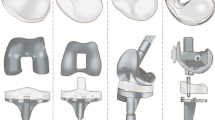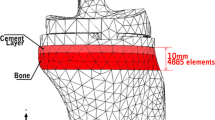Abstract
Purpose
Wear and survival of total joint replacements do not depend on the duration of the implant in situ, but rather on the amount of its use, i.e. the patient’s activity level. With this in mind, the present study was driven by two questions: (1) How does total knee replacement (TKR) respond to the simulation of daily highly demanding activities? (2) Are certain activities to be advised against or, on the contrary, useful to implanted patients, in order to reduce wear of TKR and its related problems?
Methods
One set of the same total knee prosthesis (TKP), equal in design and size, was tested on a three-plus-one knee joint simulator for two million cycles using a highly demanding daily load waveform, replicating a stair-climbing movement. The results were compared with a set of TKP previously tested with the ISO level walking task. A digital microscope was used to characterise the superficial structure of all the TKPs. Gravimetric and micro-Raman spectroscopic analyses were carried out on the polyethylene inserts. Visual comparison with in vivo explants was carried out.
Results
The average volumetric mass loss after two million cycles was 44 ± 6 mm3. Microscope examinations showed some deep scratches along the flexion/extension movements for all the components. Also, the metallic backside surface showed intense non-linear scratches and the polyethylene counterface was characterised by some craters. A decrease in crystallinity, induced by mechanical stress was observed on all polyethylene components and was quantitatively confirmed by the orthorhombic fraction αo value.
Conclusions
The results of this study demonstrated that the forces and motion sustained by the knee are highly activity-dependent. Moreover, this test confirmed that under more severe conditions, the material properties change according to a different wear mechanism and a decrease in crystallinity occurs. Loading characteristics for specific activities should be considered for the design of functional and robust TKRs.




Similar content being viewed by others
References
RIPO (2010) Register of the Orthopaedic Prosthetic Implants. Available from: https://ripo.cineca.it/
Carr AJ, Robertsson O, Graves S et al (2012) Knee replacement. Lancet 379:1331–1340. doi:10.1016/S0140-6736(11)60752-6
Vasileios N, Dimitrios C, Babis G (2014) Common controversies in total knee replacement surgery: current evidence. World J Orthop 5(4):460–468
Falez F (2014) Knee arthroplasty today. Int Orthop 38:221–225. doi:10.1007/s00264-013-2274-x
Jonas SC, Shah R, Mitra A, Deo SD (2014) 5-Year cost/benefit analysis of revision of failed unicompartmental knee replacements (UKRs); not “just” a primary total knee replacement (TKR). Knee 21:840–842. doi:10.1016/j.knee.2014.04.012
Bosco JA, Karkenny AJ, Hutzler LH et al (2014) Cost burden of 30-day readmissions following medicare total hip and knee arthroplasty. J Arthroplasty 29:903–905. doi:10.1016/j.arth.2013.11.006
Rohman L, Hadi S, Whitwell G (2014) Surgeons’ knowledge about the costs of orthopaedic implants. J Orthop Surg 22:221–223
Kapadia BH, McElroy MJ, Issa K et al (2014) The economic impact of periprosthetic infections following total knee arthroplasty at a specialized tertiary-care center. J Arthroplasty 29:929–932. doi:10.1016/j.arth.2013.09.017
Schwiesau J, Schilling C, Kaddick C et al (2013) Definition and evaluation of testing scenarios for knee wear simulation under conditions of highly demanding daily activities. Med Eng Phys 35:591–600. doi:10.1016/j.medengphy.2012.07.003
Morlock M, Schneider E, Bluhm A et al (2001) Duration and frequency of every day activities in total hip patients. J Biomech 34:873–881
Windsor RE, Scuderi GR, Moran MC, Insall JN (1989) Mechanisms of failure of the femoral and tibial components in total knee arthroplasty. Clin Orthop Relat Res 1989(248):15–19. doi:10.1097/00003086-198911000-00005, discussion 19–20
Cheng T, Pan X, Liu T, Zhang X (2012) Tibial component designs in primary total knee arthroplasty: should we reconsider all-polyethylene component? Knee Surg Sport Traumatol Arthrosc 20:1438–1449. doi:10.1007/s00167-011-1682-y
Grupp TM, Kaddick C, Schwiesau J et al (2009) Fixed and mobile bearing total knee arthroplasty—influence on wear generation, corresponding wear areas, knee kinematics and particle composition. Clin Biomech 24:210–217
Schmalzried TP, Shepherd EF, Dorey FJ et al (2000) The John Charnley award. Wear is a function of use, not time. Clin Orthop Relat Res 381:36–46
Rowe PJ, Myles CM, Walker C, Nutton R (2000) Knee joint kinematics in gait and other functional activities measured using flexible electrogoniometry: how much knee motion is sufficient for normal daily life? Gait Posture 12:143–155. doi:10.1016/S0966-6362(00)00060-6
Protopapadaki A, Drechsler WI, Cramp MC et al (2007) Hip, knee, ankle kinematics and kinetics during stair ascent and descent in healthy young individuals. Clin Biomech 22:203–210. doi:10.1016/j.clinbiomech.2006.09.010
Brockett CL, Jennings LM, Fisher J (2011) The wear of fixed and mobile bearing unicompartmental knee replacements. Proc Inst Mech Eng H 225:511–519. doi:10.1177/2041303310393824
DesJardins JD, Banks SA, Benson LC et al (2007) A direct comparison of patient and force-controlled simulator total knee replacement kinematics. J Biomech 40:3458–3466. doi:10.1016/j.jbiomech.2007.05.022
Desjardins JD, Walker PS, Haider H, Perry J (2000) The use of a force-controlled dynamic knee simulator to quantify the mechanical performance of total knee replacement designs during functional activity. J Biomech 33:1231–1242
Affatato S, Grillini L, Battaglia S et al (2013) Does knee implant size affect wear variability? Tribol Int 66:174–181
Essner A, Herrera L, Hughes P, Kester M (2011) The influence of material and design on total knee replacement wear. J Knee Surg 24:9–17
Haider H (2009) Tribological assessment of UHMWPE in the knee. In: Kurtz S (ed) UHMWPE biomaterials handbook, 2nd edn. Elsevier, Amsterdam, pp 381–408
ISO DIS 14243-1 (2002) Implants for surgery—Wear of total knee joint prostheses—Part 1: loading and displacement paramenters for wear-testing machines with load control and corresponding enviromental conditions for tests. International Organization for Standardization, Geneva
ISO DIS 14243-3 (2004) Implants for surgery—Wear of total knee joint prostheses—Part 1: loading and displacement paramenters for wear-testing machines with displacement control and corresponding enviromental conditions for tests. International Organization for Standardization, Geneva
Affatato S, Bracco P, Costa L et al (2012) In vitro wear performance of standard, crosslinked, and vitamin-E-blended UHMWPE. J Biomed Mater Res A 100:554–60. doi:10.1002/jbm.a.33297
Knight LA, Pal S, Coleman JC et al (2007) Comparison of long-term numerical and experimental total knee replacement wear during simulated gait loading. J Biomech 40:1550–8. doi:10.1016/j.jbiomech.2006.07.027
Brach del Prever EM, Bistolfi A, Bracco P, Costa L (2009) UHMWPE for arthroplasty: past or future? J Orthop Traumatol 10:1–8. doi:10.1007/s10195-008-0038-y
Cottrell JM, Babalola O, Furman BS, Wright TM (2006) Stair ascent kinematics affect UHMWPE wear and damage in total knee replacements. J Biomed Mater Res Part B Appl Biomater 78:15–19. doi:10.1002/jbm.b.30451
Battaglia S, Taddei P, Tozzi S et al (2014) Toward the interpretation of the combined effect of size and body weight on the tribological performance of total knee prostheses. Int Orthop. doi:10.1007/s00264-014-2297-y
Schwiesau J, Schilling C, Utzschneider S et al (2013) Knee wear simulation under conditions of highly demanding daily activities—Influence on an unicompartmental fixed bearing knee design. Med Eng Phys 35:1204–1211. doi:10.1016/j.medengphy.2012.12.015
Battaglia S, Belvedere C, Abdel Jaber S, Affatato S, D’Angeli V, Leradini A (2014) A new protocol from real joint motion data for wear simulation in total knee arthroplasty: stair climbing. Med Eng Phys 36:1605–1610
Wimmer MA, Andriacchi TP, Natarajan RN et al (1998) A striated pattern of wear in ultrahigh-molecular-weight polyethylene components of Miller-Galante total knee arthroplasty. J Arthroplasty 13:8–16. doi:10.1016/S0883-5403(98)90069-9
Affatato S, Vandelli C, Bordini B, Toni A (2001) Fluid absorption study in ultra-high molecular weight polyethylene (UHMWPE) sterilized and unsterilized acetabular cups. Proc Inst Mech Eng [H] 215:107–111
ISO DIS 14243-2 (2009) Implants for surgery—Wear of total knee-joint prostheses—Part 2: methods of measurement. International Organization for Standardization
Belvedere C, Tamarri S, Notarangelo DP et al (2013) Three-dimensional motion analysis of the human knee joint: comparison between intra- and post-operative measurements. Knee Surg Sports Traumatol Arthrosc 21:2375–83. doi:10.1007/s00167-012-2271-4
Catani F, Belvedere C, Ensini A et al (2011) In-Vivo knee kinematics in rotationally unconstrained total knee arthroplasty. J Orthop Res 29:1484–1490. doi:10.1002/jor.21397
Fantozzi S, Benedetti MG, Leardini A et al (2003) Fluoroscopic and gait analysis of the functional performance in stair ascent of two total knee replacement designs. Gait Posture 17:225–234. doi:10.1016/S0966-6362(02)00096-6
D’Angeli V, Belvedere C, Ortolani M et al (2013) Load along the femur shaft during activities of daily living. J Biomech 46:2002–2010. doi:10.1016/j.jbiomech.2013.06.012
D’Angeli V, Belvedere C, Ortolani M et al (2014) Load along the tibial shaft during activities of daily living. J Biomech 47:1198–1205. doi:10.1016/j.jbiomech.2014.01.045
Leardini A, Sawacha Z, Paolini G et al (2007) A new anatomically based protocol for gait analysis in children. Gait Posture 26:560–571. doi:10.1016/j.gaitpost.2006.12.018
Cappozzo A, Catani F, Della Croce U, Leardini A (1995) Position and orientation in space of bones during movement: anatomical frame definition and determination. Clin Biomech 10:171–178. doi:10.1016/0268-0033(95)91394-T
McHellop H, Lu BBP (1992) Friction, lubrication and wear of cobalt-chromium, alumina and zirconia hip prostheses compared on a joint simulator. In: Trans 38th Ann Meeting Orthop Res Soc, Washington D.C., p 402
Mutter R, Stille W, Strobl G (1993) Transition regions and surface melting in partially crystalline polyethylene: a Raman spectroscopic study. J Polym Sci B Polym Phys 31:99–105
Galetz MC, Glatzel U (2010) An activated energy approach for accelerated testing of the deformation of UHMWPE in artificial joints. J Mech Behav Biomed Mater 3:331–338. doi:10.1016/j.jmbbm.2010.01.004
Simis KS, Bistolfi A, Bellare A, Pruitt LA (2006) The combined effects of crosslinking and high crystallinity on the microstructural and mechanical properties of ultra high molecular weight polyethylene. Biomaterials 27:1688–94
Karuppiah KSK, Bruck AL, Wang J, Xu ZH, Li X (2008) Friction and wear behavior of ultra-high molecular weight polyethylene as a function of polymer crystallinity. Acta Biomater 4:1401–1410
Acknowledgments
The authors thank Alberto Leardini (Movement Analysis Laboratory, Istituto Ortopedico Rizzoli, Bologna) for his help with the data from fluoroscopy. This work was partially supported by the Italian Program of Donation for Research “5 per mille”, year 2010.
Conflict of interest
The authors declare that they have no conflict of interest.
Author information
Authors and Affiliations
Corresponding author
Rights and permissions
About this article
Cite this article
Jaber, S.A., Taddei, P., Tozzi, S. et al. In vitro effects on mobile polyethylene insert under highly demanding daily activities: stair climbing. International Orthopaedics (SICOT) 39, 1433–1440 (2015). https://doi.org/10.1007/s00264-014-2622-5
Received:
Accepted:
Published:
Issue Date:
DOI: https://doi.org/10.1007/s00264-014-2622-5




